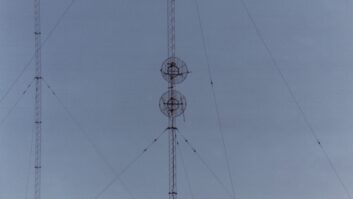STL white spaces? Apparently so.
Sep 1, 2008 12:00 PM, Chriss Scherer
[email protected]
The digital rollout in radio is in full force, and will be covered in plenty of sessions at the NAB Radio Show and AES convention. And while HD Radio is the obvious leader, there are occasional blips from FM Extra still on the radar. So as we in radio move carefully along with our rollout, our TV brethren are hard at work ensuring that they are ready for their February deadline. The next five months will move very fast for them.

The TV transition causes ripples that extend far beyond a TV station’s concern. Because the frequencies in the 700MHz band are being auctioned for new uses, these frequencies will no longer be available for auxiliary uses, such as wireless mics. This was further reinforced by the FCC’s recent ruling to ban wireless mic use in this spectrum. Other TV bands are also at risk of new interference as attention turns to use of the so-called TV white spaces.
All this activity is forcing wireless mic users on a scavenger hunt for new spectrum. Unfortunately, it looks like radio could see a new threat of potential interference. This time, the threat is aimed at your STL.
Location Sound, an installer and vendor of pro audio production equipment, featured an article in its summer/fall 2008 newsletter about a new-found band that has nothing to do with TV or the DTV transition. The article also calls this particular spectrum wide-open and available for production use.
Where is this panacea of spectrum? It’s hiding between 944MHz and 952MHz. How fortunate for wireless mic users that this piece of RF real estate is just waiting to be used.
The newsletter mentions that Lectrosonics, Shure and Sennheiser sell equipment for use in this band, but the company also notes that �this band is allowed for production use under the same regulations as the regular UHF wireless microphones.� Since most non-broadcast wireless mic users have no knowledge of FCC rules, saying that the 950MHz mics fall under the usage guidelines as other mics is a misleading statement.
As I read the article, the claims of �no TV channels operating in this band� made me shake my head. But when I read, �In some areas, it is used as a station-to-transmitter [sic] link; however, with most stations using a fiber optic line for the link, the spectrum often goes unused,� I was stunned.
Location Sound is using the band for wireless mics at a venue in the Universal Studios theme park. The newsletter continued, �An area scan in the 944 block showed it to be almost completely open. We could not believe it!� I can’t believe it either.
The FCC database lists 82 licensed paths in use in Los Angeles. From the ground, STL and other links may not be so visible on whatever scanner the company used.
The Society of Broadcast Engineers has taken note of this use, and I expect something will be filed to protect the broadcast auxiliary services users trying to share the heavily congested 944MHz – 952MHz space. If you have experienced any interference with your STL or other link in this band, I hope you’ll contact your nearest FCC field office and the SBE.
What’s your opinion? Send it to[email protected]
�
Want to read the newsletter?
www.locationsound.com/pdf/Newsletter.pdf
�












